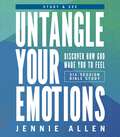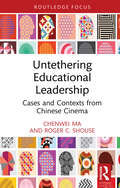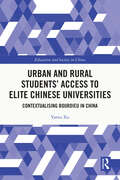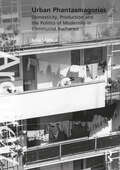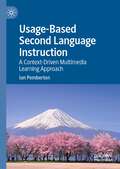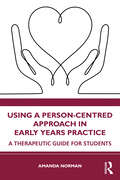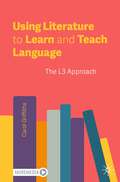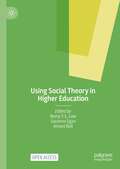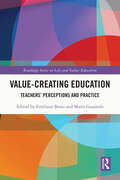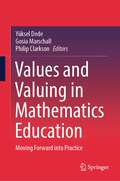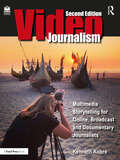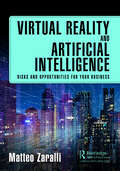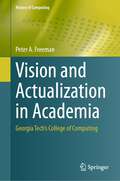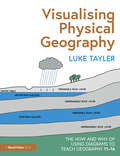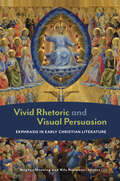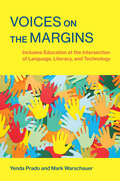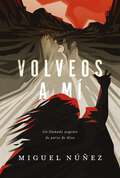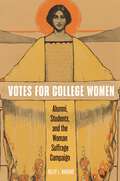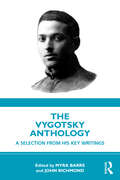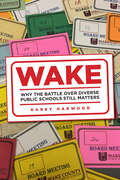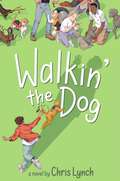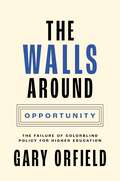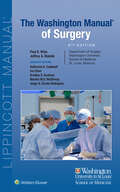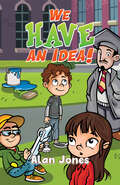- Table View
- List View
Unsettling Choice: Race, Rights, and the Partitioning of Public Education
by Ujju AggarwalHow the Great Recession revealed a system of school choice built on crisis, precarity, and exclusion What do universal rights to public goods like education mean when codified as individual, private choices? Is the &“problem&” of school choice actually not about better choices for all but, rather, about the competition and exclusion that choice engenders—guaranteeing a system of winners and losers? Unsettling Choice addresses such questions through a compelling ethnography that illuminates how one path of neoliberal restructuring in the United States emerged in tandem with, and in response to, the Civil Rights movement. Drawing on ethnographic research in one New York City school district, Unsettling Choice traces the contestations that surfaced when, in the wake of the 2007–2009 Great Recession, public schools navigated austerity by expanding choice-based programs. Ujju Aggarwal argues that this strategy, positioned as &“saving public schools,&” mobilized mechanisms rooted in market logics to recruit families with economic capital on their side, thereby solidifying a public sphere that increasingly resembled the private—where contingency was anticipated and rights for some were marked by intensified precarity for poor and working-class Black and Latinx families. As Unsettling Choice shows, these struggles over public schools—one of the last remaining universal public goods in the United States—were entrapped within neoliberal regimes that exceeded privatization and ensured exclusion even as they were couched in language of equity, diversity, care, and rights. And yet this richly detailed and engaging book also tracks an architecture of expansive rights, care, and belonging built among poor and working-class parents at a Head Start center, whose critique of choice helps us understand how we might struggle for—and reimagine—justice, and a public that remains to be won. Retail e-book files for this title are screen-reader friendly with images accompanied by short alt text and/or extended descriptions.
Untangle Your Emotions Bible Study Guide plus Streaming Video: Discover How God Made You to Feel
by Jennie AllenWhat does the Bible tell us about our emotions?Does the Bible really tell us that our emotions are untrustworthy? God made us to feel our emotions, to examine and share them—not manage or suppress them. We can learn what it means to live emotionally-healthy lives from studying Jesus&’ life and how He cared for and responded to the people around Him.Join Jennie Allen for the Untangle Your Emotions Bible Study as she helps you discover that emotions that are submitted to God and used for the purposes God intends connect us to each other and to Him.This six-session study will equip you to:Be encouraged through the examples of emotion in Scripture by God the Father, Jesus, and the Holy Spirit.Identify the unhealthy ways you might be coping with emotions.Learn a biblical step-by-step method to help you process, name, and notice what you are feeling.Move from apathetic to articulate when it comes to sharing what you feel. This study guide includes:Individual access to six streaming video sessionsPersonal study between sessionsLeader&’s Guide
Untethering Educational Leadership: Cases and Contexts from Chinese Cinema
by Chenwei Ma Roger C. ShouseLingdao, the Chinese word for leadership, is rarely used to denote acts of social persuasion that occur outside of contexts of formal rank or status. However, the ubiquity of informal leadership in China raises a number of practical and theoretical questions. Based on an analysis of selected Chinese cinematic works depicting settings of educational practice and policy, the book explores how "Western" understandings of leadership emerge from these texts to form discursive media for social change. It also offers a new understanding of lingdao and leadership; how they represent a natural human desire, regardless of formal rank or position, to mobilize collective will, change minds, and achieve social change. The book will be of interest to professional scholars and graduate students of Chinese culture, educational leadership, mass media, and popular culture.
Urban and Rural Students’ Access to Elite Chinese Universities: Contextualising Bourdieu in China (Education and Society in China)
by Yanru XuStudies have shown the disparities between urban and rural students accessing elite universities in China, a phenomenon which Xu explores in this groundbreaking book. She argues that such disparities follow a Bourdieusian capital approach showing how urban parents increased capital benefits the advancement of their children’s education. This book qualitatively explores urban and rural students’ life stories prior to their elite university entry through interviews with both parents and students. It seeks a ‘reflective reappropriation’ of Bourdieu’s notions in understanding Chinese urban and rural students’ academic success. In addition to the implications for Chinese domestic and international scholars’ understanding of the mediating role of rurality, higher education access and Chinese policymakers’ ongoing initiatives on the hukou reform, this book promotes the global reflections on the development and promotion of national analytical concepts in understanding contextualised educational issues to advance knowledge co-production. An engaging text that will be of interest to students and researchers across the fields of global higher education and sociology of education in East Asia, as well as policymakers working towards increased participation, equity, and social justice in higher education worldwide.
Urban Phantasmagorias: Domesticity, Production and the Politics of Modernity in Communist Bucharest (Architext)
by Iulia StăticăUrban Phantasmagorias examines the legacies of socialist housing in the city of Bucharest during the period of communist rule in Romania. The book explores the manner in which the socialist state reconfigured the city through concrete acts of demolition and construction, as well as indirectly through legal frameworks aimed at the regulation of women’s reproductive agency, in an attempt to materialize its idea of modernity. It follows the effects of this state agenda with a focus on the period between 1965 and 1989 through an investigation of the transformations, representations, meanings, and uses of domestic spaces. The book draws on Walter Benjamin’s concept of phantasmagoria, which provides a critical framework through which it articulates the dynamic relationship between ideology, architecture, and everyday practices, and reassesses their impact upon individual subjectivity and agency. The woman emerges as a central subject of the book, upon whom the phantasmagoric effects of the socialist state’s modernizing agenda have an acute impact at the level of lived domesticity and everyday life. Through a focus on the lived experiences of women, the book illuminates the prismatic effect of the state’s infrastructural and legal intentions, including the ways in which these were subverted through women’s lived bodily experiences of the home. The book establishes, both theoretically and through the concrete case of the city of Bucharest, the methodological significance of Benjamin’s notion of phantasmagoria as an epistemological approach to a modern communist cityscape. Urban Phantasmagorias is an important contribution to scholarship in architectural history and theory, urban and gender studies, and post-socialist and Eastern European studies.
Usage-Based Second Language Instruction: A Context-Driven Multimedia Learning Approach
by Ian PembertonThis book proposes an innovative pedagogical approach, Usage-Based Second Language Instruction, which continues the tradition of challenges to existing paradigms such as Steven Krashen's Natural Approach, and Michael Lewis' Lexical Approach. It begins by analysing historical teaching methods to make the case for change. The author argues that Communicative Language Teaching lacks a theory of learning and overemphasises spoken production as a result. The book then examines theories of first language acquisition to establish a theoretical basis for change. It finds that usage-based theories offer a highly plausible account of language learning. The author sets out six principles to guide the application of usage-based theory to second language learning. The book will be of particular interest to students and researchers of Applied Linguistics and Language Education.
Using a Person-Centred Approach in Early Years Practice: A Therapeutic Guide for Students
by Amanda NormanUsing a Person-Centred Approach in Early Years Practice reflects on the principles of person-centred counselling, developed by Carl Rogers. It guides students and practitioners to use this approach within the sphere of early childhood education, providing radical new ways of promoting emotions, emotional regulation and well-being. This accessible resource reveals how a therapeutic approach with a humanistic perspective can be understood and woven into early years professional practice by practitioners themselves. Exploring how educators can be supportive through empathy, understanding and congruent in developing relationships, this text provides: an overview and rationale to using a person-centred approach its association to emotions, health and well-being the role of therapeutic play in early years communities, from child, parents and wider team how a person-centred approach can impact leadership and teamwork its increasing necessity to supporting a child’s physical and emotional development during the pandemic and beyond With informed practice examples, case studies and thought-provoking questions regarding a PCA, this book will be essential and informative reading for students studying early years or early childhood courses and to practitioners looking to improve and enhance their practice.
Using Literature to Learn and Teach Language: The L3 Approach
by Carol GriffithsThis accessibly-written textbook uses the intrinsic appeal of a story to engage students with language, and provides teachers with the background knowledge and the skills to use literature to construct lessons for their classes which integrate all four skills plus language awareness in an enjoyable way. Although a number of books and studies have examined the value of using literature to learn language, literature remains under-represented as a language learning resource. The author argues that the accumulated body of literature represents a bottomless pit of potential material, just waiting to be recognised and enjoyed. From a teacher’s point of view, a lesson based on a literary work can provide an integrated approach to language development which few other approaches can match. A piece of literature can be used to develop all four skills, both receptive and productive (reading, writing, listening speaking) as well as production skills and language awareness. This book willbe an essential resource for pre-service and in-service teachers, teacher trainers, students and scholars of Applied Linguistics, Language Education, TESOL and related subjects.
Using Social Theory in Higher Education
by Remy Y. S. Low Suzanne Egan Amani BellThis open access book offers a unique and refreshing view on working with social theory in higher education. Using engaging first-person accounts coupled with critical intellectual analysis, the authors demonstrate how theory is grappled with as part of an ongoing practice rather than a momentary disembodied encounter. In a structure that creates a space for relational dialogue, each chapter is followed by a response from another author, demonstrating the varied interpretive possibilities of social theory. Collectively the authors invite the reader to engage with them in questioning the usefulness of social theory in higher education teaching and research, in considering its possibilities and limits, and in experiencing the opportunity it offers to understand ourselves and our work differently. Written in a way that is scholarly yet accessible, the contributors explore how social theories can be used to think through issues that are emerging as key social and political concerns in higher education and beyond. The book will be of interest to advanced undergraduates, postgraduates, and early-career academics, as well as established scholars.
Value-Creating Education: Teachers’ Perceptions and Practice (Routledge Series on Life and Values Education)
by Emiliano Bosio Maria GuajardoOffering a pivotal reference point and a wide range of global perspectives of teaching experiences on value-creating education (VCE), this book is a timely spotlight on contemporary issues of globalisation that many educational institutions around the world may encounter. It contributes to the originality of constructing new knowledge in the field of VCE, a forward-looking framework, and an ethical and educational imperative that can be understood in different ways, from diverse theoretical orientations. The chapters written by experienced international educators explore the following questions: How do educators understand the role of VCE? What pedagogical approaches to VCE do educators employ in their classes? How do educators support the values and knowledge of VCE in all curricular areas? What do educators see as the key essential values and knowledge that students should develop through VCE? It offers valuable insights and applied pedagogical practices for postgraduate students, researchers, educational policy makers, curriculum developers, and decision-makers in higher education institutions and non-governmental organizations (e.g., UNESCO, OXFAM).
Values and Valuing in Mathematics Education: Moving Forward into Practice
by Yüksel Dede Gosia Marschall Philip ClarksonThis book is a follow-up to 'Values and Valuing in Mathematics Education: Scanning and Scoping the Territory' (2019, Springer). This book adds a critical emphasis on practice and fosters thinking concerning positive mathematical well-being, engagement, teacher noticing, and values alignment among a range of critical notions that intersect with values and valuing. Values and valuing play a key role in many aspects of education, such as assessment, planning, classroom interactions, choosing tasks, and general well-being. What one values and finds important in the learning and teaching of mathematics operates within the intersection of all social, cognitive, and affective aspects of school pedagogy, making values a significant holistic factor in education. The chapters explore potential teaching strategies that enhance the understanding of the central place of values in mathematics itself as a subject, as well as how values impact how mathematics is used withinsociety. This book includes examples of strategies for facilitating students’ meaningful engagement with, and conscious learning of, values when engaging in mathematical thinking and doing.
Videojournalism: Multimedia Storytelling for Online, Broadcast and Documentary Journalists
by Kenneth KobreVideojournalism: Multimedia Storytelling for Online, Broadcast and Documentary Journalists is an essential guide for solo video storytellers—from "backpack" videojournalists to short-form documentary makers to do-it-all broadcast reporters.Based on interviews with award-winning professionals sharing their unique experiences and knowledge, Videojournalism covers topics such as crafting and editing eye-catching short stories, recording high-quality sound, and understanding the laws and ethics of filming in public and private places. Other topics include:• understanding the difference between a story and a report• finding a theme and telling a story in a compact time frame• learning to use different cameras and lenses—from smart phones to mirrorless and digital cinema cameras• using light, both natural and artificial • understanding color and exposureThe second edition of this best-selling text has been completely revised and updated. Heavily illustrated with more than 550 photographs, the book also includes more than 200 links to outstanding examples of short-form video stories. Anatomy of a News Story, a short documentary made for the book, follows a day in the life of a solo TV videojournalist on an assignment (with a surprise ending), and helps readers translate theory to practice.This book is for anyone learning how to master the art and craft of telling real, short-form stories with words, sound, and pictures for the Web or television.A supporting companion website links to documentaries and videos, and includes additional recommendations from the field’s most prominent educators.
Virtual Reality and Artificial Intelligence: Risks and Opportunities for Your Business
by Matteo ZaralliTechnology is rapidly transforming the way people learn and train, and the integration of virtual reality (VR) and artificial intelligence (AI) could be the next big breakthrough. With the advent of Web 3.0 and the Metaverse, there are endless possibilities for creating immersive and engaging learning environments. However, there is also a need to address the risks and challenges that these technologies present.This book explores the risks and opportunities of VR and AI for coaching and training, with an eye toward the emerging trends of Web 3.0 and the Metaverse. Coaching and training have become increasingly important for companies seeking to develop and retain talent. With the advent of VR and AI technology, there is an opportunity to create immersive and engaging learning environments that could greatly enhance the learning experience. However, there are also risks associated with the use of these technologies, such as data privacy and cybersecurity.This book provides an in-depth analysis of the risks and opportunities of VR and AI for coaching and training, to help startup and business executives understand how to use these technologies responsibly and effectively. We need a new perspective. The book discusses the intersection of various major subjects and topics: business, innovation, technology, and philosophy in terms of critical thinking. The transition we are experiencing through this new Intelligent Revolution is very important, and soon everyone will witness the shift from e-learning to v-learning.
Vision and Actualization in Academia: Georgia Tech’s College of Computing (History of Computing)
by Peter A. FreemanAlthough difficult, change in academic structures is necessary today, especially in fast-changing fields today such as biology, computing, management, the social sciences, and others. This includes changes within existing organizations as well as creation of new structures and reorganizations or eliminations of older ones. This narrative attempts first to document the historical rise of an organization, Georgia Tech’s College of Computing, that has touched and successfully changed the lives of thousands of people. Second, it aims to identify and explicate some of what has led to this widely acknowledged success. The book provides a chronological narrative that highlights major changes taken under each successive leader. These changes have built on one another, knowingly or otherwise, to create a growing organization that rivals in size and prominence longer established parts of the university. The case study, while of an academic organization focused on computing, provides general lessons applicable almost anywhere. Topics and features: Discusses the nature and uses of visions, both general and specificShows how visions can be used to drive specific actions and resource allocationsIllustrates the choice and use of enduring organizational principlesOutlines a simple strategic-planning method and its applicationIndicates results of this overall approach This book will be of interest to anyone interested in organizational change, especially in academia, and to those interested in Georgia Tech. It will also appeal to policymakers in education, government, and industry; as well as anyone interested in the historical growth of the computing milieu broadly. Peter A. Freeman was Founding Dean and Professor in the College of Computing at Georgia Tech from 1990 to 2002. Today he is an Emeritus Dean and Professor.
Visualising Physical Geography: The How and Why of Using Diagrams to Teach Geography 11–16
by Luke TaylerThis practical guide breaks down the complex and broad field of physical geography, demonstrating how diagrams can be used by teachers to effectively explain the key concepts behind many natural processes and landforms. Featuring over 200 diagrams that cover the key topics taught in Key Stage 3 and 4 Geography, the book shows teachers how they can convey age-appropriate concepts without overwhelming or oversimplifying. Supported by summaries of background knowledge, common misconceptions, questions to check understanding, and extension activities, the concepts and topics explored include: Rocks and weathering Plate tectonics Rivers Coasts Weather and climate Ecosystems Glaciation Backed by research and evidence to support the use of diagrams in the classroom, this is an essential read for any geography teacher or subject lead who wants to support their students in learning key concepts in physical geography.
Vivid Rhetoric and Visual Persuasion: Ekphrasis in Early Christian Literature
by Edited by Meghan Henning and Nils NeumannA major scholarly collaboration exploring vivid visual rhetoric in the New Testament From Jesus&’s miraculous walk on water to the graphic horrors of hell, New Testament authors make vivid and unforgettable images appear before their audience&’s eyes. In the past decade, scholarship on early Christian use of ancient rhetorical techniques has flourished. One focus of rhetorical criticism of the New Testament has been the function of ekphrasis, or vivid visual description. In this landmark collection, leading New Testament scholars come together to probe the purpose and import of ekphrasis in early Christian literature. The research in this collection explores the relationship between vivid rhetoric and genre, taking into account technical features, authorial intent, and audience response. Specific topics include: • The New Testament&’s rhetoric compared against Greco-Roman rhetorical handbooks • Juxtaposition between vivid and non-vivid rhetoric • The use of energeia in John&’s Gospel to draw upon the reader&’s multiple senses • Aesthetics and the grotesque in Revelation • The use of travelogue to create a virtual journey for the audience • Vivid rhetoric in early martyr literature Vivid Rhetoric and Visual Persuasion is a must-read for scholars of early Christianity and rhetorical criticism. Readers will find this collection indispensable in understanding a complex feature of the New Testament in its historical context. ContributorsContributors Bart B. Bruehler, Diane Fruchtman, Meghan Henning, Martina Kepper, Susanne Luther, Harry O. Maier, Gudrun Nassauer, Nils Neumann, Vernon K. Robbins, Gary S. Selby, Aldo Tagliabue, Sunny Kuan-Hui Wang, Annette Weissenrieder, Robyn J. Whitaker
Voices on the Margins: Inclusive Education at the Intersection of Language, Literacy, and Technology
by Yenda Prado Mark WarschauerA rich view of inclusive education at the intersection of language, literacy, and technology—drawing on case study research in a diverse full-inclusion US school before, during, and after the COVID-19 pandemic.Despite advancing efforts at integration, the segregation of students with disabilities from their nondisabled peers persists. In the United States, 34 percent of all students with disabilities spend at least 20 percent of their instructional time in segregated classrooms. For students with intellectual or multiple disabilities, segregated placement soars to 80 percent. In Voices on the Margins, Yenda Prado and Mark Warschauer provide an ethnography of an extraordinary full-inclusion public charter school in the western United States—Future Visions Academy. And they ask: What does it mean to be inclusive in today&’s schools with their increasingly pervasive use of digital technologies?Voices on the Margins examines the ways digital technologies support inclusion and language and literacy practices for culturally and linguistically diverse children with and without disabilities. A wide range of qualitative data collected in the case study illuminates three central themes: (1) the kinds of social organization that allow a fully inclusive environment for children with disabilities to thrive, (2) the ways that digital technologies can be used to help students express their voice and agency, while developing language and literacy skills, and (3) the ways that digital technologies can be used to foster stronger networks and connections between students, teachers, staff, and parents.
Volveos a mí: Un llamado urgente de parte de Dios
by Miguel NúñezEn Volveos a mí, el Dr. Miguel Núñez presenta de qué manera a lo largo de la historia redentora el pueblo de Dios se ha rebelado contra el mismo Dios que le ha traído la libertad, y cómo Dios, en medio de la infidelidad de Su pueblo, ha permanecido fiel y ha hecho todos los esfuerzos posibles para llamar a Su pueblo de regreso a Su presencia. Desde que Dios formó la nación de Israel miles de años atrás, la tendencia del pueblo de Dios ha sido alejarse de manera recurrente de su Creador y Redentor para volverse a sus malos caminos. Por otro lado, ha sido siempre el deseo de Dios de llamar a Su pueblo de regreso a Él, reconociendo que, alejados de Él, cosecharán grandes y destructivas consecuencias; y solamente en la cercanía con Él pueden experimentar Sus bendiciones. Cada uno de los capítulos de este libro considera diferentes momentos de la historia redentora donde el pueblo de Dios se había alejado y donde Dios le llamó de regreso a Su presencia.&“Volveos a mí&” es una frase que aparece en Zacarías 1:3 donde Dios dice lo siguiente: &“Diles, pues: &‘Así dice el Señor de los ejércitos: &“Volveos a mí&” —declara el Señor de los ejércitos— y yo me volveré a vosotros&” —dice el Señor de los ejércitos. . .&” En este versículo se ve el corazón de un Dios que desea tener comunión con Su pueblo para poderle instruir, dirigir, proteger y bendecir. Return to MeIn Return to Me, Dr. Miguel Núñez presents how throughout redemptive history God's people have rebelled against the very God who has brought them freedom, and how God, in the midst of His people's unfaithfulness, has remained faithful and made every effort to call His people back to His presence. Since God formed the nation of Israel thousands of years ago, the tendency of God's people has been to repeatedly turn away from their Creator and Redeemer and turn back to their wicked ways. On the other hand, it has always been God's desire to call His people back to Him, recognizing that, separated from Him, they will reap great and destructive consequences; and only in closeness to Him can they experience His blessings. Each of the chapters of this book considers different moments in redemptive history where God's people had fallen away and where God called them back into His presence.&“Return to me&” is a phrase that appears in Zechariah 1:3 where God says the following: &“Therefore say to them, 'Thus says the LORD of hosts, &“Return to Me,&” declares the LORD of hosts, &“and I will return to you,&” says the LORD of hosts . . .&” In this verse we see the heart of a God who desires to commune with His people so that He can instruct, direct, protect, and bless them.
Votes for College Women: Alumni, Students, and the Woman Suffrage Campaign
by Kelly L. MarinoExplores the College Equal Suffrage League’s work to advance the campaign for the Nineteenth AmendmentThe woman suffrage movement is often portrayed as having been led and organized by middle-aged women and mothers in stuffy, formal settings. This dominant account grossly neglects a significant demographic within the movement—college women. Between 1870 and 1910, the proportion of college women in the United States rose from 21 to 40 percent. By 1880, there were 155 private colleges in the Northeast and the South for female students and numerous coeducational institutions in the West. The widespread extension of academic training for women helped spur a well-organized campaign for female voting rights on college campuses, where suffragists found a new audience and stage to earn respect and support.Votes for College Women examines archives from the College Equal Suffrage League (CESL), established in 1900 as an affiliate of the National American Woman Suffrage Association, to illustrate the outsize and dynamic role that young women played in the woman suffrage movement. The book vividly illustrates how the CESL’s campaigns served a dual purpose: not only did they invigorate the Nineteenth Amendment campaign at a crucial moment, but they also brought about a profound transformation in the culture of women’s organizing and higher education. Furthermore, Kelly L. Marino argues that the CESL’s campaigns set trends in youth activism and helped lay the groundwork for later and more well-known college protests against gender inequality. Fascinating and timely, Votes for College Women shows how these brave women solidified the campus and the classroom as arenas for civic and social activism.
The Vygotsky Anthology: A Selection from His Key Writings
by Myra Barrs John RichmondThe Vygotsky Anthology brings together, for the first time, a selection of extracts from the best translations available of Vygotsky’s writings, spanning the entire arc of his career.Vygotsky was arguably one of the greatest educational psychologists of the 20th century. Grounded in his experience as a teacher, an expert in special education, a research psychologist and an outstanding theorist, the editors of this unique anthology chart his enormous influence on professionals working in education and child development around the world. The extracts are introduced by the editors’ commentaries, helpfully setting them in the context of Vygotsky’s life and work, providing a collection of work that adequately represents his writing, and conveying some of the great pleasures of reading him. In the passages selected here, his voice is clearly heard, the intellectual brilliance of his insights is reflected, his line of argument is clear, and his humour and humanity are evident.With its inclusion of recent translations of essential texts, this anthology will help students to understand the full diversity of Vygotsky’s influence on today’s classrooms. Seen as a companion volume to Myra Barrs’ previous work Vygotsky the Teacher (Routledge, 2022), the value of this text to teachers, educational psychologists, and other practitioners working in the field of education and child development will be significant and lasting. It is a key reference book for new generations of Vygotsky students.
Wake: Why the Battle over Diverse Public Schools Still Matters (Critical Issues in American Education)
by Karey Alison HarwoodThe Wake County Public School System was once described as a beacon of hope for American school districts. It was both academically successful and successfully integrated. It accomplished these goals through the hard work of teachers and administrators, and through a student assignment policy that made sure no school in the countywide district became a high poverty school. Although most students attended their closest school, the “diversity policy” modified where some students were assigned to make sure no school had more than 40% of its students qualifying for free or reduced-price lunch or more than 25% performing below grade level. When the school board election of 2009 swept into office a majority who favored “neighborhood schools,” the diversity policy that had governed student assignment for years was eliminated. Wake: Why the Battle Over Diverse Public Schools Still Matters tells the story of the aftermath of that election, including the fierce public debate that ensued during school board meetings and in the pages of the local newspaper, and the groundswell of community support that voted in a pro-diversity school board in 2011. What was at stake in those years was the fundamental direction of the largest school district in North Carolina and the 14th largest in the U.S. Would it maintain a commitment to diverse schools, and if so, how would it balance that commitment with various competing interests and demands? Through hundreds of published opinion articles and several in depth interviews with community leaders, Wake examines the substance of that debate and explores the community’s vision for public education. Wake also explores the importance of knowing the history of a place, including the history of school segregation. Wake County’s example still resonates, and the battle over diverse public schools still matters, because owning responsibility for the problem of segregated schools (or not) will shape the direction of America’s future.
Walkin' the Dog
by Chris Lynch&“Lynch is back and better, smarter, and funnier than ever.&” —Jacqueline Woodson, National Book Award Winner A boy learns how to be a friend from man&’s best friend in this funny and moving middle grade novel about humans being able to change and dogs changing us from acclaimed author Chris Lynch.In a family of strong personalities with very strong points of view, Louis is what his mother lovingly calls &“the inactivist,&” someone who&’d rather kick back than stand out. He only hopes he can stay under the radar when he starts high school in the fall, his first experience with public school after years of homeschooling. But when a favor for a neighbor and his stinky canine companion unexpectedly turns into a bustling dog-walking business, Louis finds himself meeting an unprecedented number of new friends—both human and canine. Agatha, a quippy and cagey girl his age always seems to be telling two truths and a lie. Cyrus, a few years his senior, promises he&’s going to show Louis how to be a better person, whether Louis wants him to or not. And then there are the dogs: misbehaving border terriers, the four (possible stolen) sausage dogs, the rest of Louis&’s charges, and a mysterious white beast who appears at a certain spot at the edge of the woods. Dogs and human alike all seem to have something they want to teach Louis, including his menacing older brother who keeps turning up everywhere. But is Louis ready to learn the lesson he needs most: how to stop being a lone wolf and be part of a pack?
The Walls around Opportunity: The Failure of Colorblind Policy for Higher Education (Our Compelling Interests #8)
by Gary OrfieldThe case for race-conscious education policyIn our unequal society, families of color fully share the dream of college but their children often attend schools that do not prepare them, and the higher education system gives the best opportunities to the most privileged. Students of color hope for college but often face a dead end.For many young people, racial inequality puts them at a disadvantage from early childhood. The Walls around Opportunity argues that colorblind policies have made college inaccessible to a large share of students of color, and reveals how policies that acknowledge racial inequalities and set racial equality goals can succeed where colorblindness has failed.Gary Orfield paints a troubling portrait of American higher education, explaining how profound racial gaps imbedded in virtually every stage of our children&’s lives pose a major threat to communities of color and the nation. He describes how the 1960s and early 1970s was the only period in history to witness sustained efforts at racial equity in higher education, and how the Reagan era ushered in today&’s colorblind policies, which ignore the realities of color inequality. Orfield shows how this misguided policy has resegregated public schools, exacerbated inequalities in college preparation, denied needed financial aid to families, and led to huge price increases over decades that have seen little real gain in income for most Americans.Now with a new afterword that discusses the 2023 Supreme Court decision to outlaw affirmative action in college admissions, this timely and urgent book shows that the court&’s colorblind ruling is unworkable in a society where every aspect of opportunity and preparation is linked to race, and reveals the gaps in the opportunity pipeline while exploring the best ways to address them in light of this decision.
The Washington Manual of Surgery
by Paul E. Wise Jeffrey A. BlatnikFocusing on must-know information in the broad spectrum of general surgery, The Washington Manual® of Surgery, 9th Edition, provides concise, high-yield content essential for surgical residents, attendings, medical students, and others who provide care for patients with surgical disease. Edited by Drs. Paul E. Wise and Jeffrey A. Blatnik, and written by teams of Washington University residents and faculty, this bestselling manual presents state-of-the-art, comprehensive information in a brief, outline format, along with numerous figures, tables, algorithms, and images throughout. In one convenient, portable resource, you’ll find practical coverage of all surgical subspecialties (thoracic, GI, colorectal, cardiac, vascular, breast, trauma, critical care, and more)—all at your fingertips for quick review and reference.
We Have an Idea!
by Alan JonesChildren are the heroes of this book! Although they are in school to be taught by the adults, they are the ones who really know how to get things done. They are the ones who care for their environment, who can identify a problem, and, above all, who know how to get things moving! They are unwavering in their determination and ability to act! Parents and teachers will find opportunities within the text to promote children’s recognition of rhyme, ability to make predictions and understanding of figurative language and the use of idioms as a way of communicating meaning.

